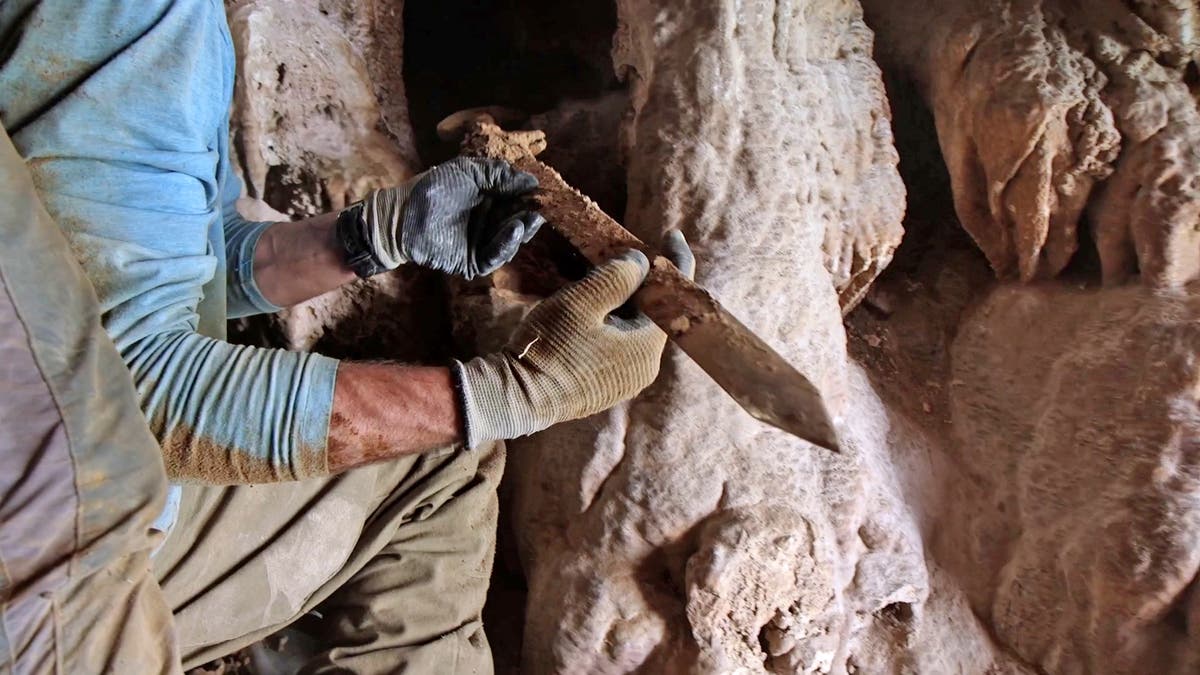A cache of “excellently preserved” 1,900-year-old Roman swords have been unearthed in a cave close to the Lifeless Sea by archaeologists in Israel.
The swords have been possible seized and hidden by insurgent Jewish forces as “booty” following a battle, stated researchers, together with these from the Israel Antiquities Authority (IAA).
The 4 uncommon swords, of which three blades have been nonetheless protected in picket and leather-based sheaths, have been present in a small hidden collapse an space of inaccessible cliffs north of En Gedi within the Judean Desert Nature Reserve.
A “shafted weapon” was additionally present in a crevice within the cave, researchers stated in a press release by the IAA.
“Discovering a single sword is uncommon – so 4? It’s a dream! We rubbed our eyes to imagine it,” they stated.
Archaeologists initially entered the cave with the purpose of photographing a Paleo-Hebrew inscription written on the stalactite, hoping it might assist decipher extra components of the inscription.
Israeli archaeologists present 4 Roman-era swords and a javelin head discovered throughout a latest excavation in a cave close to the Lifeless Sea, in Jerusalem
(AP)
Whereas scoping the cave’s higher degree, archaeologist Asaf Gayer from Ariel College noticed a particularly well-preserved Roman pilum or javelin – a shafted weapon – in a deep slim crevice.
He additionally found items of wooden in an adjoining area of interest that turned out to be components of the swords’ scabbards.
Returning to the cave at a later time, researchers carried out a “meticulous survey” of all of the crevices and located the 4 Roman swords in an virtually inaccessible crevice on the cave’s higher degree.
Historic swords, believed by the Israel Antiquities Authority to be from the Roman period courting again 1,900 years and located in a weapons cache in a collapse an Israeli desert, are displayed in Jerusalem
(REUTERS)
The swords have been discovered to be “exceptionally properly preserved” and three of the iron blades have been nonetheless inside their picket scabbards.
Researchers additionally discovered leather-based strips in addition to picket and steel components customary into handles for the blades.
“The size of the blades of three swords was 60-65 cm, their dimensions figuring out them as Roman spatha swords, and the fourth one was shorter with c. 45 cm lengthy blade, recognized as a ring-pommel sword,” the IAA stated in a press release.
Primarily based on an preliminary examination, researchers stated the swords have been commonplace weapons employed by the Roman troopers stationed in Judea within the Roman interval.
Eradicating the swords from the crevice the place they have been hidden
(Emil Aladjem, Israel Antiquities Authority)
“The hiding of the swords and the pilum in deep cracks within the remoted cave north of En Gedi, hints that the weapons have been taken as booty from Roman troopers or from the battlefield, and purposely hidden by the Judean rebels for reuse,” stated Eitan Klein, one of many administrators of the survey mission.
“Clearly, the rebels didn’t need to be caught by the Roman authorities carrying these weapons. We’re simply starting the analysis on the cave and the weapon cache found in it, aiming to attempt to discover out who owned the swords, and the place, when, and by whom they have been manufactured,” Dr Klein stated.
Conservators Ilan Naor and Lena Kupershmidt with the swords
(Emil Aladjem, Israel Antiquities Authority)
Scientists are conducting additional evaluation to “pinpoint” the precise historic occasion that will have led to the caching of those weapons within the cave.
Additional excavation of the collapse its entirety has additionally uncovered artifacts courting to the Chalcolithic interval of about 6,000 years in the past.
Researchers have revealed particulars of the findings in a ebook titled New Research within the Archaeology of the Judean Desert: Collected Papers.









